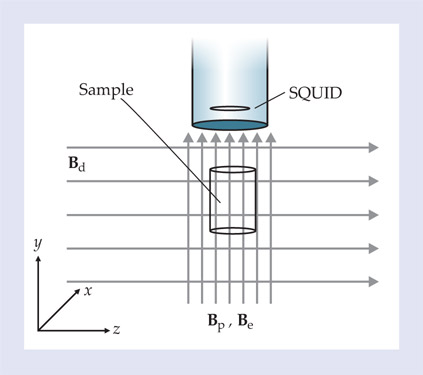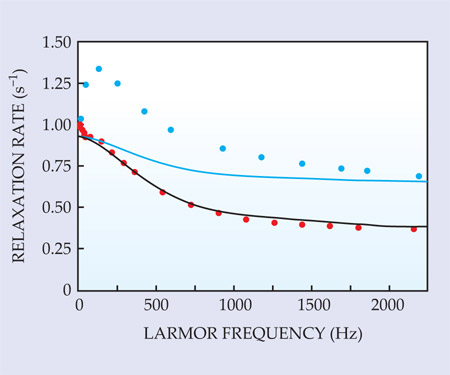Ultralow magnetic fields elicit unexplained spin dynamics in water
DOI: 10.1063/PT.3.1280
Placed in an external magnetic field, nuclear spins respond by dancing a two-step: They wobble, or precess, about the field axis, and polarize in the field direction. At room-temperature in a 100-µT field—comparable to that of an ordinary bar magnet—it takes water’s spin-1⁄2 hydrogen nuclei about 10 seconds to relax, or achieve equilibrium polarization. In a 10-µT field, the spins relax in roughly 3⁄4 the time.
The difference has to do with the protons’ precession rate, or Larmor frequency, which is proportional to magnetic field intensity. As the Larmor frequency decreases, slower mechanisms can contribute to the relaxation process. At 100 µT, a proton’s Larmor frequency is about 4 kHz, and spin relaxation is facilitated mostly by thermal fluctuations. At 10 µT the lower Larmor frequency of about 400 Hz allows proton exchange between H3O+ and H2O and between H2O and OH− to help usher the system to equilibrium. The increase in the relaxation rate occurs around Larmor frequencies near 700 Hz (17 µT), roughly the same frequency with which protons hop between the various water complexes.
Aided by a superconducting quantum interference device (SQUID), low-field nuclear magnetic resonance experts at the National Metrology Institute in Berlin have now discovered yet another jump in water’s spin-relaxation rate. 1 Led by Stefan Hartwig and Martin Burghoff, the team stumbled across the jump while probing relaxation at the ultralow Larmor frequencies produced by nanotesla fields, previously uncharted territory for NMR experiments.
A slow precession
As sketched in figure 1, the Berlin group subjected a water sample to a succession of three static magnetic fields. To start, they generated a polarization field Bp in the vertical direction. That field, a few millitesla in intensity, induces a spin polarization of about ten parts per billion in the water sample—about a thousand times weaker than in conventional NMR, but still too strong to reveal new spin dynamics.

Figure 1. A water sample’s ultralow-field spin dynamics are measured with a succession of three fields: a polarization field Bp that gives the sample its initial magnetization; an ultralow evolution field Be that causes the magnetization decay; and a detection field Bd that induces precession about the z-axis. The resulting oscillating signal is detectable by a superconducting quantum interference device (SQUID). (Adapted from ref.

Next, they switched off Bp and switched on a much weaker, coaligned evolution field Be. Incorporating a feedback control scheme to counter field induction, they could achieve that switch in less than a millisecond. In Be, the precession of water’s protons slows down, and the sample’s magnetization begins to decay exponentially. Charting that decay over time gives what’s known as the longitudinal relaxation rate R1.
But the magnetic field generated by the faintly polarized water is minute, as small as a few picotesla. To accurately measure it, the researchers switched off Be after some time τ and switched on the horizontally oriented detection field Bd. At that instant, water’s upward-pointing magnetization vector M begins to precess about the detection field, which causes the vertical component of its magnetic field, detected by a nearby SQUID magnetometer, to oscillate and decay. From that decay, the researchers could extract a reliable estimate of M at the moment Be was turned off. By measuring M(τ) for τ varying from 1 to 15 seconds and then successively repeating the procedure for Be extending to less than 1 µT, the researchers pieced together R1 values for Larmor frequencies as low as a few hertz.
The weakest fields the team probed were less than 1/500 the strength of Earth’s geomagnetic field. At those intensities, even tiny fluctuations due to ambient RF waves would have foiled the experiment had the team not availed itself of the institute’s state-of-the-art magnetically shielded room.
“They must have been extremely meticulous measurements,” says Michelle Espy of Los Alamos National Laboratory, whose group also does ultralow-field NMR experiments. “At microtesla and below, magnetization from things that ordinarily are negligible can suddenly swamp what you’re trying to measure.”
A mystery mechanism
The Berlin team’s low-field measurements weren’t merely an exercise; they also revealed surprising physics. Apart from the expected rise due to proton exchange reactions, the measured R1 values, shown in red in figure 2, also display an unexplained uptick as the Larmor frequency drops below 100 Hz.

Figure 2. Water’s longitudinal relaxation rate R1 (red symbols), at which proton spins align with an external magnetic field, agrees with theory (black curve) when the protons’ Larmor precession frequency is above 100 Hz. The deviation at lower frequencies suggests that in very weak fields, an as-yet-unknown mechanism aids spin relaxation. (The symbols intersect the vertical axis at about 1.0 s−1; the curve intersects at about 0.9 s−1.) The transverse relaxation rate R2 (blue symbols), at which precessing spins decohere, exceeds theoretical predictions (blue curve) over a larger range. For both measurements, oxygen-17-enriched water was used, which enhanced spin–spin coupling. (Adapted from ref.

Follow-up experiments suggest the rate increase has to do with coupling between H+ nuclei and spin-5⁄2 17O nuclei. But as to the exact mechanism, Hartwig concedes, “We don’t have a good explanation. Right now, we’re hoping other theorists can offer some ideas.”
Also sure to keep theorists busy are the team’s measurements of water’s transverse relaxation rate R2, at which precessing nuclear spins decohere. The researchers obtained those measurements with the same experimental setup, except they bypassed the evolution field and switched directly from Bp to Bd. The resulting oscillations in My have a Fourier peak corresponding to the Larmor frequency at Bd. The width of that peak gives R2.
The measured R2 values, shown in blue in figure 2, exceed theoretical predictions and thus again implicate an as-yet-unknown relaxation mechanism. In a win for theory, however, the long-held principle that R1 and R2 should converge as the Larmor frequency approaches zero appears to hold true.
More surprises in store?
The usefulness of ultralow-field NMR extends beyond creating challenging theoretical puzzles. For example, experiments have hinted that healthy and cancerous tissues can be distinguished by their longitudinal relaxation times—a strategy known as T1 contrasting—but only in microtesla fields and lower. Hartwig is not alone in suspecting that the same may be true of other materials; Espy, for one, hopes to use T1 contrasting as a noninvasive way to identify explosive materials.
But as Espy puts it, for all the potential applications, “there’s also real science to be discovered at low fields. We’ve thought for a long time that ultra-low-field NMR might reveal interesting molecular dynamics, but now the Berlin team has actually shown it—surprising things really do happen down there.”
References
1. S. Hartwig et al., J. Chem. Phys. 135, 054201 (2011). https://doi.org/10.1063/1.3623024
2. M. Burghoff et al., App. Phys. Lett. 87, 054103 (2005). https://doi.org/10.1063/1.2006981




